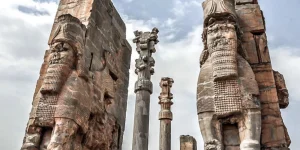The Persian Gulf, located in the heart of the Middle East, is one of the world’s most strategic and historically rich maritime regions. This waterway has shaped global trade, geopolitics, and cultural development for centuries. Here are 12 fascinating facts about the Persian Gulf that highlight its significance in maritime history, environmental importance, and modern economy.
The name Persian Gulf is deeply rooted in history, originating from the era of the Persian Empire, established by the great Iranian ruler Cyrus the Great around 500 BC. As one of the most powerful empires in ancient history, the Persian Empire expanded its influence across vast regions, leaving an enduring legacy reflected in the name of this vital waterway. Historical records, maps, and texts from the past 2,500 years consistently refer to it as the Persian Gulf, affirming its authentic and historically recognized name throughout millennia.


–

1. Geographical Importance
The Persian Gulf stretches approximately 990 kilometers (615 miles), bordered by eight countries, including Iran, Iraq, Saudi Arabia, and the UAE. It connects to the Arabian Sea through the Strait of Hormuz, a crucial maritime chokepoint.
Example: Around 30% of the world’s seaborne oil passes through the Strait of Hormuz, making the Persian Gulf indispensable for global energy supply.
2. Rich History and Ancient Trade
The Persian Gulf has been a trade route for thousands of years, serving as a key link in the ancient Silk Road network. It connected the Middle East with Asia, Africa, and Europe.
Historical Insight: Ancient Mesopotamian civilizations, including the Sumerians and Babylonians, traded extensively through Persian Gulf ports like Ur and Dilmun (modern-day Bahrain).
3. Major Oil and Gas Reserves
The Persian Gulf holds some of the largest oil and natural gas reserves in the world. Key oil-producing countries, including Iran, Iraq, Kuwait, and Saudi Arabia, rely heavily on this waterway for exports.
Case Study: Saudi Arabia’s Ras Tanura and Iran’s Kharg Island are two of the largest oil export terminals situated on the Persian Gulf’s shores.
4. Diverse Marine Ecosystem
The Persian Gulf is home to a unique marine ecosystem, supporting coral reefs, mangrove forests, and over 500 fish species. Endangered species like the dugong and hawksbill sea turtle also inhabit its waters.
Conservation Efforts: Countries bordering the Gulf have initiated marine conservation programs to protect its fragile ecosystems from pollution and habitat loss.
5. Strategic Maritime Shipping Route
The Persian Gulf is one of the busiest shipping corridors globally, supporting massive oil tankers, container ships, and cargo vessels. Ports like Jebel Ali in the UAE are among the world’s largest and busiest.
Example: Jebel Ali Port in Dubai handles over 19 million TEUs (Twenty-foot Equivalent Units) annually, connecting trade routes from Asia, Africa, and Europe.
6. Hotbed of Geopolitical Tensions
Throughout modern history, the Persian Gulf has been a flashpoint for geopolitical conflicts, including the Iran-Iraq War (1980-1988), the Gulf War (1990-1991), and ongoing disputes related to maritime security.
Security Measures: International naval coalitions frequently patrol the region to secure shipping lanes and ensure the uninterrupted flow of oil and goods.
7. Cultural and Historical Heritage Sites
The region is rich in historical sites, including ancient ruins, Islamic architectural landmarks, and UNESCO World Heritage Sites.
Cultural Highlight: Iran’s historic port city of Bandar Abbas and Kuwait’s Failaka Island are renowned for their archaeological significance and historical legacy.
8. Fishing and Pearl Diving Traditions
Before the oil boom, the Persian Gulf’s economy relied heavily on fishing and pearl diving. Coastal communities thrived on these maritime activities, which are still celebrated in regional culture and festivals.
Cultural Note: Qatar’s annual Pearl Diving Festival showcases the region’s maritime heritage through traditional boat races and cultural events.
9. Environmental Challenges
The Persian Gulf faces environmental threats, including oil spills, overfishing, and rising sea temperatures due to climate change.
Case Study: The 1991 Gulf War oil spill, one of the worst environmental disasters in history, released over 10 million barrels of oil into the Persian Gulf, causing extensive ecological damage.
10. Unique Geographical Features
The Gulf’s shallow waters and high salinity levels create a unique environment that supports rare marine species. Its islands, such as Qeshm and Abu Musa, are rich in biodiversity and geological wonders.
Example: Qeshm Island, located in Iran, is recognized as a UNESCO Global Geopark for its stunning rock formations, caves, and mangrove forests.
11. Regional Economic Powerhouse
Many Persian Gulf countries have transformed into economic powerhouses due to their oil wealth, with cities like Dubai, Doha, and Manama becoming global business hubs.
Economic Insight: The Gulf Cooperation Council (GCC) countries have heavily invested in infrastructure, finance, and tourism to diversify their economies beyond oil.
12. Hub of International Relations
The Persian Gulf serves as a central platform for international diplomacy, regional cooperation, and security agreements.
Diplomatic Initiatives: Global organizations like the United Nations and the International Maritime Organization (IMO) play crucial roles in facilitating peace, resolving disputes, and ensuring maritime security.
Conclusion: The Persian Gulf’s Timeless Significance
From ancient trade routes to modern energy exports, the Persian Gulf has maintained its prominence in maritime history and global commerce. Its complex blend of economic, cultural, and geopolitical significance ensures that this vital waterway will continue to shape the future of international trade, diplomacy, and environmental conservation.

